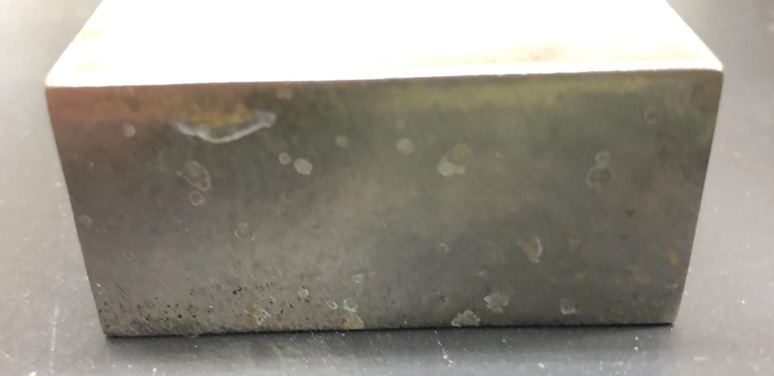Nippon Mecha Chemical Co. Ltd.
Feb 13, 2025
Is Rust Removal and Prevention for Cast Iron Difficult? – Tips for Using Rust Inhibitors to Prevent Re-Rusting –
A customer using Rust Remover K-200 in a hot and humid region contacted us with the following concern:
“I have been removing rust from cast iron, but a whitish residue remains on the surface.”
Cast iron is prone to forming small gaps due to its composition and crystalline structure.
These gaps are extremely small, only visible under an electron microscope.
Even after applying or immersing a rusty cast iron workpiece in a rust remover and then washing it with water, some rust remover may remain trapped in these microscopic gaps.
Over time, the residual rust remover can damage the surrounding base metal, causing white or black discoloration.
These discolored areas act as seeds for future rust formation, eventually leading to visible rust.

*Image of discoloration of cast iron
Experimental Verification of Post-Treatment Methods
To explore effective post-treatment methods for cast iron rust removal, we conducted the following experiment:
We prepared two FCD600 test pieces and removed surface rust using Rust Remover K-200, followed by wiping with water.
Ⓐ One piece was left to air dry naturally.
Ⓑ The other piece underwent the following treatment:
-
- Neutralization and rust prevention using MECHA HIBITOR #325, followed by wiping with a dry cloth.
- Application of CP-4000 as an additional protective layer.
Results: The piece Ⓑ treated with rust prevention steps (1 & 2) showed a significant reduction in rust recurrence.

*MECHA HIBITOR #325 neutralizes acidic surfaces after the rust removal process, bringing them to a neutral to mildly alkaline state, making them more resistant to rust.
Additionally, it provides temporary rust prevention for several days, making it effective for rust removal and rust prevention processes on materials prone to rusting.
Furthermore, by using the oil-based rust inhibitor CP-4000, the rust prevention effect was enhanced, which is believed to have led to the difference observed in this case.
Key Considerations for Rust Removal in Hot and Humid Environments
In hot and humid regions, rust can begin reforming immediately after removal, making it challenging to maintain a rust-free surface.
Therefore, using the right rust inhibitor and ensuring quick post-treatment are essential.
Additionally, when treating a large surface area, the first treated sections may have already started re-rusting before completing the entire process.
To avoid this, divide the work into smaller sections and apply rust removal and prevention sequentially.
While every rust remover and inhibitor have performance limitations, we provide tailored recommendations to maximize effectiveness based on your specific working environment.
Feel free to contact us for further assistance!
